The mystery of the aquarium tiger barb…
It is often said that a tiger never loses its stripes, but what about its name? Matt Ford investigates…
Cases in which a fish long thought to be one species turns out to represent something else are not especially unusual within the aquarium hobby. Notable examples include that of the ‘arulius barb’, for many years referred to as Puntius arulius (Jerdon 1849) but now confirmed as Dawkinsia tambraparniei (Silas 1954), and the ‘kuhli loach’, normally identified as Pangio kuhlii (Valenciennes 1846), a species which may never have been traded.
The common aquarium tiger barb is referred to as ‘Puntius tetrazona‘ throughout aquarium literature and is without doubt among the most recognisable fish in the hobby. It has been a popular ornamental subject for decades and both its natural and artificial colour forms are farmed on an enormous scale, with collection of wild examples virtually unheard of.
Less widely-known is that there exist five officially-recognised ‘tiger barb’ species, these all sharing a similar colour pattern comprising 4 dark, vertical bars and a yellowish body. In nature they range throughout Indochina and certain parts of the Greater Sunda Islands, where they typically inhabit freshwater swamps, streams, and marginal zones of larger rivers.
They were formerly dubbed the ‘Puntius tetrazona group’ and have often been referred to the genus Systomus following Rainboth (1996), but currently constitute the genus Puntigrus Kottelat 2013.
What is interesting about the commercially-produced ‘aquarium’ tiger barb is it does not appear to key out as any of the described species in terms of diagnostic characters:
Puntigrus anchisporus (Vaillant 1902): lateral line complete; 14 circumpeduncular scales; 21-23+2 scales in the lateral row; dorsal-fin black with red outer band; pelvic fins red.
Distribution: western Borneo.
Puntigrus navjotsodhii Tan 2012: lateral line complete; 20-21 scales in the lateral row; dorsal-fin mostly black with red anterior portion and red outer band; pelvic fins almost entirely red; dark body bars wide, covering up to 5 scales.
Distribution: central Borneo.
Puntigrus partipentazona (Fowler 1934): lateral line incomplete; dorsal-fin mostly black with red anterior portion and red outer band; pelvic fins reddish to yellowish; dark blotch on the dorsal-fin uniquely extending onto the body, covering 3-4 scale rows, sometimes with an additional dark marking beneath.
Distribution: Indochina.
Puntigrus pulcher (Rendahl 1922): lateral line incomplete; 12 circumpeduncular scales; 19-21+2 scales in the lateral row; dorsal fin entirely black; pelvic fins entirely black; dark body bars relatively thin, covering up to 1.5 scales.
Distribution: eastern Borneo.
Puntigrus tetrazona (Bleeker 1855): lateral line incomplete; 12 circumpeduncular scales; 19-21+2 scales in the lateral row; dorsal fin mostly black with paler outer margin; pelvic fins black in middle, hyaline at base and tip; dark body bars relatively wide, covering up to 2.5 scales.
Distribution: Sumatra.
The aquarium tiger barb exhibits characters which do not precisely match any of those above: lateral line incomplete, dorsal-fin black with red outer band, pelvic fins red. Meanwhile some of the ornamental strains such as the ‘green’ and ‘platinum’ forms possess variable degrees of black pigmentation in the pelvic fins, thus clouding the issue further.
In terms of colour pattern the aquarium fish perhaps resembles P. anchisporus most closely in that they both have solid red pelvic fins, but P. anchisporus has a complete lateral line which the commercially-produced individuals do not.
Collins et al. (2012) noted that Kottelat (1993) reported 8-9 pored lateral line scales for P. tetrazona, while specimens from the aquarium trade examined in their study had 6-7 or 10-13. In addition the image from Kottelat (1993) depicting P. tetrazona clearly shows a fish with almost entirely black pelvic fins, as per the image of a wild individual featured here.
Given that colour pattern and the number of pored lateral line scales are used as principal distinguishing characteristics within the genus Puntigrus, it thus appears impossible to say whether the aquarium fish is an undescribed taxon, artificial hybrid, or has been farmed to the point where it no longer resembles its natural form.
In the SF Knowledge Base it is still included under P. tetrazona as per Collins et al. (2012), who concluded that it should be retained there “for the time being”, while for aquarists the identity of the tiger lurking in our tanks continues to remain an unsolved mystery.
References:
Alfred, E. R., 1963. Some Colourful Fishes of the Genus Puntius Hamilton. Bulletin of the National Museum of Singapore 32: 135-142.
Bleeker, P. 1855. Nalezingen op de vischfauna van Sumatra. Visschen van Lahat en Sibogha. Natuurkundig Tijdschrift voor Nederlandsch Indië v. 9: 257-280
Collins, R., K. F. Armstrong, R. Meier, Y. Yi, S. D. J. Brown, R. H. Cruickshank, S, Keeling, C. Johnston, 2012 – Barcoding and Border Biosecurity: Identifying Cyprinid Fishes in the Aquarium Trade. PLoS ONE 7(1): e28381
Fowler, H. W. 1934. Zoological results of the third De Schauensee Siamese Expedition, Part V–Additional fishes. Proceedings of the Academy of Natural Sciences of Philadelphia v. 86: 335-352.
Kottelat, M., 1992. The identity of Barbus johorensis Duncker, 1904 (Teleostei: Cyprinidae). Raffles Bulletin of Zoology 40(2): 187-192.
Kottelat, M., 2013. The fishes of the inland waters of southeast Asia: a catalogue and core bibiography of the fishes known to occur in freshwaters, mangroves and estuaries. Raffles Bulletin of Zoology Supplement 27: 1-663
Kottelat, M. and H. H. Tan. 2011. Systomus xouthos, a new cyprinid fish from Borneo, and revalidation of Puntius pulcher (Teleostei: Cyprinidae). Ichthyological Exploration of Freshwaters 22(3): 209-214.
Pethiyagoda, R., M. Meegaskumbura and K. Maduwage. 2012. A synopsis of the South Asian fishes referred to Puntius (Pisces: Cyprinidae). Ichthyological Exploration of Freshwaters 23(1): 69-95.
Tan, H-H. 2012. Systomus navjotsodhii, a New Cyprinid Fish from Central Kalimantan, Borneo. Raffles Bulletin of Zoology Supplement 25: 285-289.
Vaillant, L. L. 1902. Résultats zoologiques de l’expédition scientifique Néerlandaise au Bornéo central. Poissons. Notes from the Leyden Museum v. 24 (note 1): 1-166
Category: Articles, Freshwater Fishes | Tags: aquarium, Kottelat, Puntigrus, Puntius, Systomus, tiger barb | One comment »

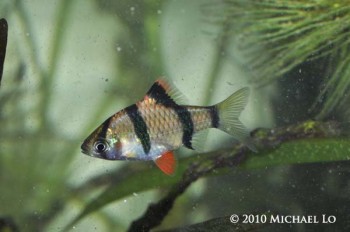

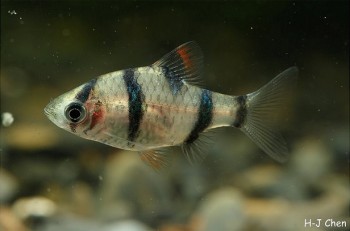
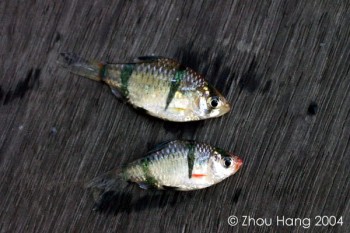
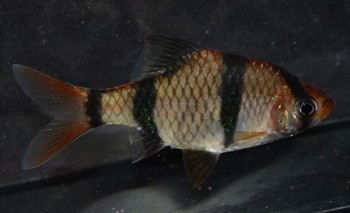
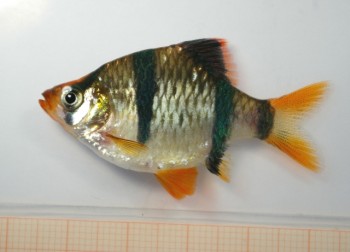


July 15th, 2015 at 9:12 pm
Have just updated this to reflect the new generic name and (finally) add in a pic of wild P. tetrazona, but all previous comments have disappeared! Big apologies folks…